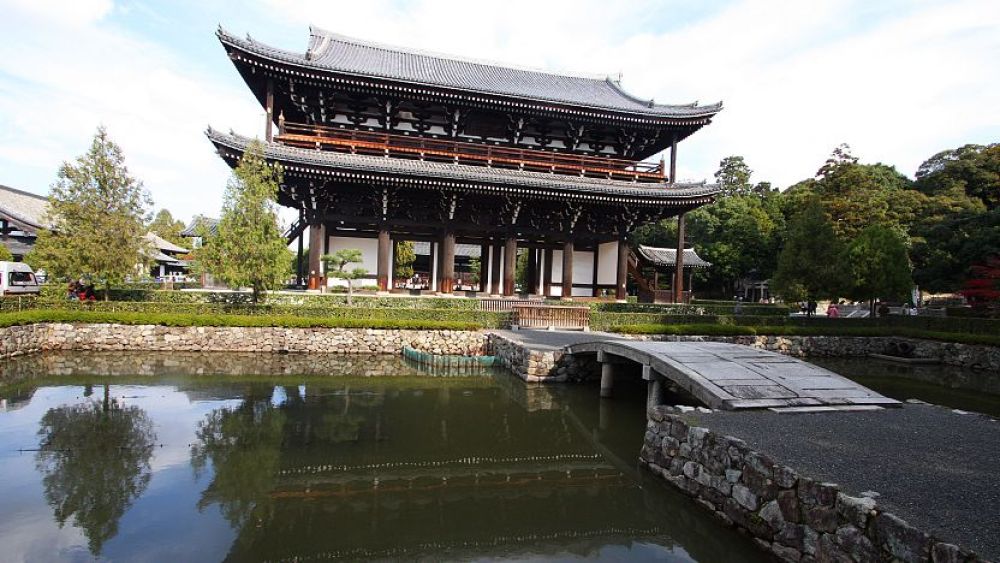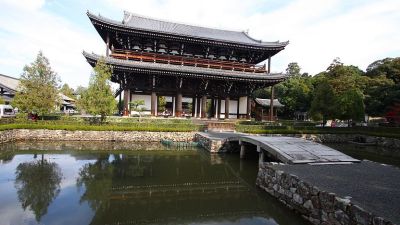

Tofukuji Temple, renowned for its stunning autumn colors, attracts numerous visitors every year who come to marvel at the red, orange, and yellow hues of its maples. The temple's expansive grounds host a variety of maple trees that create a breathtaking tapestry of colors, particularly around the Tsutenkyo Bridge, which becomes a prime viewing spot. During peak seasons, special temporary platforms are constructed to offer visitors an immersive experience amidst the foliage. Visitors walk through the temple's gardens and along its paths to take in the spectacular views. The experience is akin to a moving meditation, as the vibrant beauty of nature and the serene atmosphere of the temple grounds combine to provide a tranquil escape from the bustle of everyday life.
As a head temple of the Rinzai sect of Zen Buddhism, Tofukuji Temple offers a unique opportunity to engage in Zen meditation practices, known as Zazen. Zazen sessions are guided by the temple's monks and offer a moment of introspection and mindfulness. Designed for both beginners and seasoned practitioners alike, these sessions provide an authentic experience of traditional Zen meditation. With its long and storied history dating back to the 13th century, Tofukuji Temple's meditation hall is an inspiring setting that helps participants to focus and delve deeper into their meditation. Zazen at Tofukuji is not merely an activity; it is the chance to connect with centuries of spiritual tradition, fostering a sense of peace and spiritual wellbeing.
Tofukuji Temple offers guided tours that illuminate the rich history of this important cultural landmark. These tours, often led by knowledgeable guides, cover the temple's history, architecture, and religious significance. The temple complex includes a number of important structures, such as the Sanmon Gate, which is designated as a National Treasure, and the stunning Kaisando Hall. Additionally, the Hojo Garden should not be missed, as it is a masterpiece of Zen garden design. Throughout the journey, visitors will find themselves intrigued by the tales of the temple's founding, its impressive art, and the role it has played in Japanese Buddhism over the years. The guided tours are comprehensive, yet accessible, providing a memorable experience that appeals to history enthusiasts, architecture buffs, and spiritual seekers alike.
To complement the temple visit, Tofukuji Temple hosts a variety of cultural workshops that invite participants to get hands-on experience with traditional Japanese arts and crafts. These workshops may include calligraphy classes, where visitors learn the delicate strokes of writing kanji characters, or introductions to the Japanese tea ceremony, offering a chance to learn about its rich history and etiquette. Other possible workshops might involve flower arranging (ikebana) or incense appreciation (kodo), allowing visitors to deepen their understanding and appreciation of these longstanding cultural practices. Each workshop is carefully crafted to ensure that participants not only learn about these arts but also experience the zen and meticulous attention that is essential to Japanese culture.
For photography enthusiasts, Tofukuji Temple offers an unparalleled visual feast throughout its grounds. A photography walk can be either self-guided or led by professional photographers who know the best spots and times of day to capture the temple's beauty. Participants will find ample subjects for their lenses, from the intricate details of the temple buildings and the sweeping views of the gardens to the subtle interplay of light and shadow that dances across the stone and foliage. Whether shooting the lush greenery of the early summer, the fiery tones of autumn, or the solemn stillness of a winter’s day, photographers at Tofukuji Temple have the opportunity to capture images that are as profound as they are picturesque. Through the camera lens, the ancient beauty of Tofukuji is captured and preserved, a testimony to the temple's lasting allure.
Throughout the year, Tofukuji Temple holds various seasonal festivals that provide a glimpse into Japan's cultural and spiritual traditions. These festivals often coincide with the changing of the seasons and significant dates on the Buddhist calendar. Visitors attending these events will have the chance to see the temple come alive with ceremonial rituals, festive decorations, and local vendors selling crafts and food. One of the highlights is the autumn festival, where the temple's surroundings become a hub of activity against the stunning backdrop of fall colors. Whether celebrating the cherry blossoms in spring or paying homage to ancestors during the Obon festival in summer, Tofukuji's seasonal festivals are a vibrant, enriching experience that showcases the celebratory spirit of Kyoto.
The gardens of Tofukuji Temple are renowned for their beauty and have been designated as a place of scenic beauty by Japan's government. Visitors can enjoy a peaceful stroll through the various garden areas, including the famous Hojo Garden which consists of four distinct gardens surrounding the Hojo, the abbot's residence. These gardens represent the pinnacle of Zen garden design and feature moss gardens, rock gardens, and a pond garden. Each garden is meant to symbolize different philosophical or spiritual aspects of Zen Buddhism. Exploring the gardens offers a chance to reflect and find tranquility amidst the carefully arranged stones, pristine raked gravel, and lush moss that create a serene, minimalist aesthetic. The gardens are a compelling call to slow down and appreciate the meticulous care and attention to detail that characterize this unique form of landscaping.
Tofukuji Temple provides visitors with the opportunity to relish the changing seasons through its variety of flowering plants and trees. Springtime is marked by the delicate blossoms of cherry trees, which draw crowds eager to engage in hanami, or flower viewing parties. The temple's cherry blossoms create a canopy of pink and white, symbolizing the transient beauty of life in Japanese culture. As the seasons progress, other flowers take center stage, such as hydrangeas in the early summer with their shades of blue, pink, and purple, and the vibrant azaleas. Each season brings forth a new display, offering a fresh perspective of the temple's natural landscape. Guests can take leisurely walks to appreciate the blossoms, often framed by the temple's historical architecture, providing a harmonious blend of natural beauty and cultural heritage.
For those with a keen interest in the religious and philosophical aspects of Buddhism, Tofukuji Temple hosts a series of lectures on various topics related to the teachings of the Buddha and the history of Zen Buddhism in Japan. These lectures are often conducted by the temple's monks or guest speakers who are scholars in the field. Attendees will learn about the core principles of Buddhism, such as the Four Noble Truths and the Eightfold Path, as well as the particular practices and lineage of the Rinzai Zen sect to which Tofukuji belongs. The sessions may cover aspects of the temple's art, literature, and how Zen thought has influenced Japanese culture over the centuries. This intellectual exploration is supported by the temple's tranquil atmosphere, providing an enriching educational experience that also fostaves personal reflection and growth.
Tofkuji Temple extends an invitation to all visitors, regardless of religious background, to engage in personal prayer and reflection within its sacred spaces. The temple houses various halls and altars dedicated to different Buddhas and Bodhisattvas, allowing for a quiet moment to offer prayers, reflect, or simply sit in contemplation. The practice of personal prayer in the temple is not guided and allows individuals the freedom to connect with the spiritual atmosphere in their own way. Visitors are often moved by the serenity and spiritual presence found within the temple's walls. It is a place of solace and introspection, where one can step away from the distractions of daily life and connect with something larger than oneself. Such moments can be transformative, offering a sense of peace and clarity.
